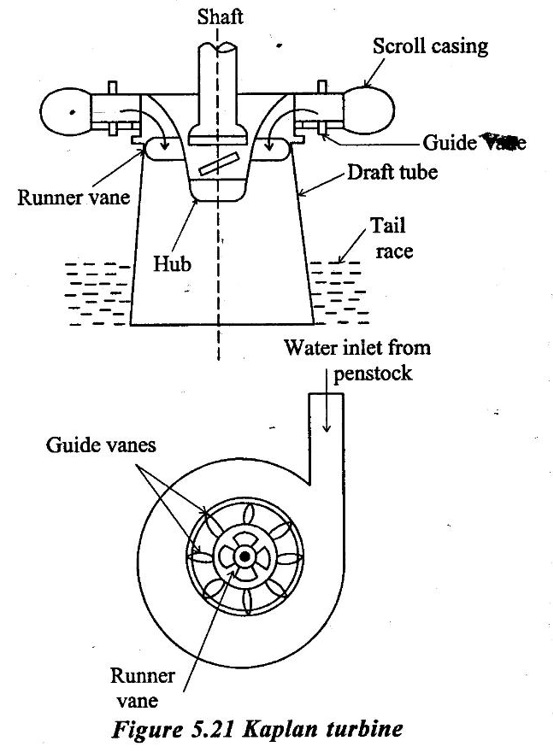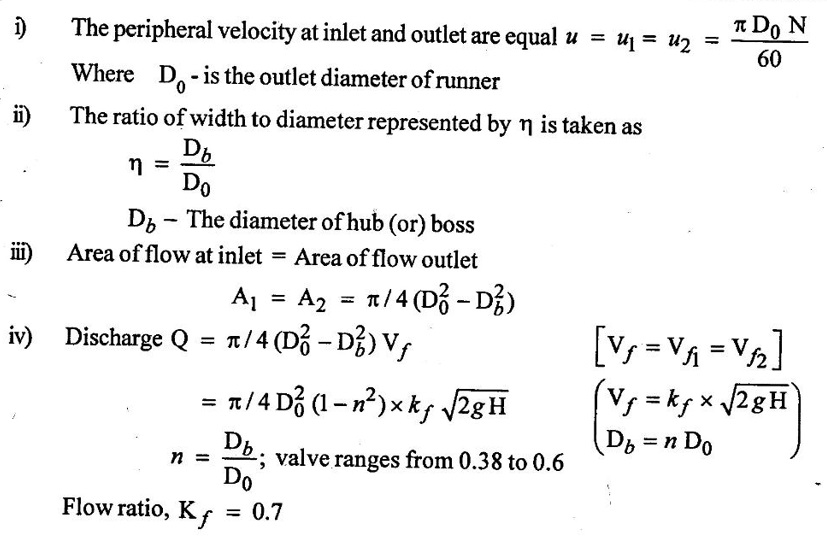The propeller and kaplan are propeller shaped axial flow reaction turbines in which the water flows parallel to the axis of the shafts.
AXIAL FLOW REACTION TURBINES - PROPELLER AND KAPLAN TURBINES
The propeller and kaplan are propeller shaped axial flow reaction turbines in which the water flows parallel to the axis of the shafts.
These turbines were developed to meet the requirement of using available large quantity of water at low heads (up to 80m)
In the year 1980, prof v. kaplan developed a propeller turbine having fixed runner blades of aerofoil section fixed to the hub of the shaft. Kaplan turbine and propeller turbine are both axial flow turbines. The main difference between two turbines, a propeller turbines has fixed blades whereas a kaplan turbines has adjustable blades. Usually 3-6 number of blades are used in this turbine. If blades more than 6, the contact surface with water increased these by the frictional resistance increases. If blades are less than 3, this result in too much reduction of contact surface with water there by energy losses in exit water increases.
Hence too much (or) too less the contact between the blades surface and water are not beneficial for us. For optimum contact surface, 3-6 number of blades are recommended, blades are made of stainless steel and mounted on the hub. The overall efficiency of a kaplan turbine can be high as 92%. Kaplan turbines are capable of taking over loads from 15% to 20% and give a very high efficiency at all the gate operating while working at full load and part load condition.
1. Characteristics of Kaplan turbines
1. At the inlet of the runner vane water possesses both kinetic energy & pressure energy.
2. Works at low head and high discharge.
3. It is high specific speed.
4. It is reaction and axial flow turbine.
5. Work done is due to partially change in kinetic energy and partially change in pressure energy.
6. Both pressure and velocity of water fall on moving vanes.
7. It is the only turbine which has adjustable blades.
2. The main components of Kaplan turbine
(a) Scroll casing
(b) Guide vanes
(c) Runner
(d) Draft tube

Scroll casing, Guide vanes and draft tube same as that of Francis turbine.
Runner:
The adjustable blades are directly attached to the hub whose position may be varied with load on the turbine and hence with the discharge as shown in figure. As the blades are adjusted for a shock free entry of flow, a high efficiency is maintained over a wide range of turbine output. A kaplan turbine runner is designed for a given head and discharge, also they works efficiently under much lower heads and at reduced discharge.
Working:
The working of kaplan turbine is similar of Francis turbine. Kaplan turbine is a type of reaction turbine and is best suited for low head and high discharge. It is a kind of axial flow turbine because the water enters to the runner and leaves parallel to the axis of the runner shaft.
The inlet and outlet velocity triangles for a kaplan turbine is similar to Francis turbine.
3. Working proportions:
The method of drawing the velocity diagram and the expressions for work, power and efficiency for kaplan turbines are identical as discussed in same Francis turbine. The working proportions are also obtained in the same manner as for Francis turbine.

Advantages of kaplan turbine:
1. For the same power developed kaplan turbine is more compact in construction and smaller in size.
2. Part load efficiency is considerably high.
3. Low frictional losses.
No comments:
Post a Comment